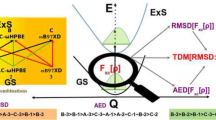Abstract
A technique known as intensity filtering is introduced to select valence-like virtual orbitals for calculating the local electron affinity, EAL. Intensity filtering allows EAL to be calculated using semiempirical molecular orbital techniques that include polarisation functions. Without intensity filtering, such techniques yield spurious EAL values that are dominated by the polarisation functions. As intensity filtering should also be applicable for ab initio or density functional theory calculations with large basis sets, it also makes EAL available for these techniques.







Similar content being viewed by others
References
Clark T, Byler KG, de Groot MJ (2008) In: Hicks MG, Kettner C (eds) Molecular interactions—bringing chemistry to life. Proceedings of the International Beilstein Workshop, Bozen, Italy, May 15–19, 2006. Logos, Berlin, pp 129–146
Politzer P, Murray JS (1991) Rev Comput Chem 2:273–312
Ehresmann B, Martin B, Horn AHC, Clark T (2003) J Mol Model 9:342–347
Politzer PA, Murray JS, Grice ME, Brinck T, Ranganathan S (1991) J Chem Phys 95:6699–6704
Politzer PA, Murray JS, Concha MC (2002) Int J Quant Chem 88:19–27
Hussein W, Walker CJ, Peralta-Inga Z, Murray JS (2001) Int J Quant Chem 82:160–169
Murray JS, Abu-Awwad F, Politzer PA (2000) Theochem 501–502:241
Ehresmann B, de Groot MJ, Alex A, Clark T (2004) J Chem Inf Comput Sci 44:658–668
Clark T (2004) J Mol Graph Model 22:519–525
Ehresmann B, de Groot MJ, Clark T (2005) J Chem Inf Model 45:1053–1060
Clark T, Ford MG, Essex JW, Richards WG, Ritchie DW (2006) QSAR and molecular modelling in rational design of bioactive molecules. In: Aki E, Yalcin I (eds) EuroQSAR 2004 proceedings. CADD&DS, Istanbul, Turkey, pp 536–537
Kramer C, Beck B, Kriegl JM, Clark T (2008) Chem Med Chem 3:254–265
Jakobi A-J, Mauser H, Clark T (2008) J Mol Model 14:547–558
Hennemann H, Friedl A, Lobell M, Keldenich J, Hillisch A, Clark T, Göller AH (2009) Chem Med Chem 4:657–669
Manallack DT (2008) J Mol Model 14:797–805
Mulliken RS (1934) J Chem Phys 2:782–793
Mulliken RS (1955) J Chem Phys 23:1833–1840
Pearson RG (1991) Chemtracts Inorg Chem 3:317–333
Parr RG, Yang W (1989) Density functional theory in atoms and molecules. Oxford University Press, New York
Fukui K, Yonezawa T, Nagata C (1957) J Chem Phys 26:831–841
Foster JP, Weinhold F (1980) J Am Chem Soc 102:7211–7218
Reid AE, Weinstock RB, Weinhold F (1985) J Chem Phys 83:735–746
Clark T, Stewart JJP (2010) In: Reimers JR (ed) Computational methods for large systems: electronic structure approaches for biotechnology and nanotechnology. Wiley, New York (in press)
Dewar MJS, Thiel W (1977) J Am Chem Soc 99:4899–4907
Dewar MJS, Thiel W (1977) J Am Chem Soc 99:4907–4917
Thiel W (1998) In: Schleyer PvR, Allinger NL, Clark T, Gasteiger J, Kollman PA, Schaefer HF III, Schreiner PR (eds) Encyclopedia of computational chemistry, vol 3. Wiley, Chichester, pp 1599–1604
Dewar MJS, Zoebisch EG, Healy EF, Stewart JJP (1985) J Am Chem Soc 107:3902–3909
Holder AJ (1998) In: Schleyer PvR, Allinger NL, Clark T, Gasteiger J, Kollman PA, Schaefer HF III, Schreiner PR (eds) Encyclopedia of computational chemistry, vol 1. Wiley, Chichester, pp 8–11
Stewart JJP (1989) J Comp Chem 10:209
Stewart JJP (1989) J Comp Chem 10:221
Stewart JJP (1998) In: Schleyer PvR, Allinger NL, Clark T, Gasteiger J, Kollman PA, Schaefer HF III, Schreiner PR (eds) Encyclopedia of computational chemistry, vol 3. Wiley, Chichester, p 2080
Winget P, Horn AHC, Selçuki C, Martin B, Clark T (2003) J Mol Model 9:408–414
Winget P, Clark T (2005) J Mol Model 11:439–456
Kayi H, Clark T (2007) J Mol Model 13:965–979
Kayi H, Clark T (2009) J Mol Model 15:295–308
Kayi H, Clark T (2009) J Mol Model 15:1253–1269. doi:10.1007/s00894-009-0489-y
Kayi H, Clark T (2009) J Mol Model 15 (in press). Online first. doi: 10.1007/s00894-009-0503-4
Orchin M, Jaffé HH (1971) Symmetry, orbitals, and spectra. Wiley, New York
Cramer C, Beck B, Clark T (2010) J Chem Inf Model 50 (in press)
ParaSurf’10, Cepos InSilico Ltd, Kempston, UK, to be released on July 1st 2010; www.ceposinsilico.com
Acknowledgements
I am grateful for constructive criticism and many stimulating discussions with Jane Murray, Peter Politzer and Felipe Bulat. This work was supported by the Deutsche Forschungsgemeinschaft as part of SFB583 "Redox-Active Metal Complexes: Control of Reactivity via Molecular Architecture".
Author information
Authors and Affiliations
Corresponding author
Rights and permissions
About this article
Cite this article
Clark, T. The local electron affinity for non-minimal basis sets. J Mol Model 16, 1231–1238 (2010). https://doi.org/10.1007/s00894-009-0607-x
Received:
Accepted:
Published:
Issue Date:
DOI: https://doi.org/10.1007/s00894-009-0607-x




